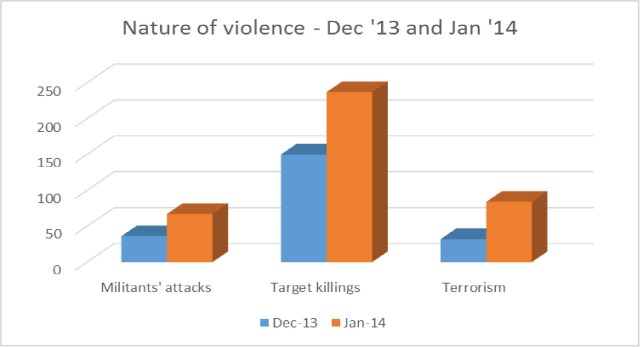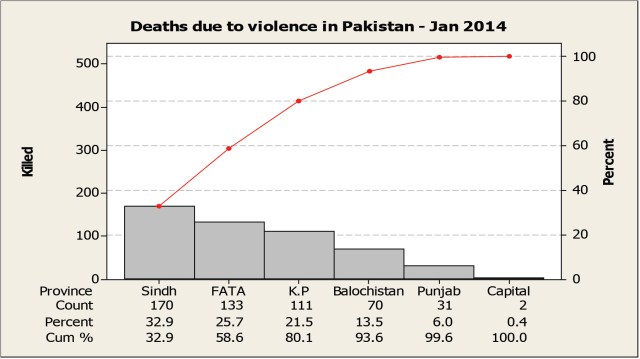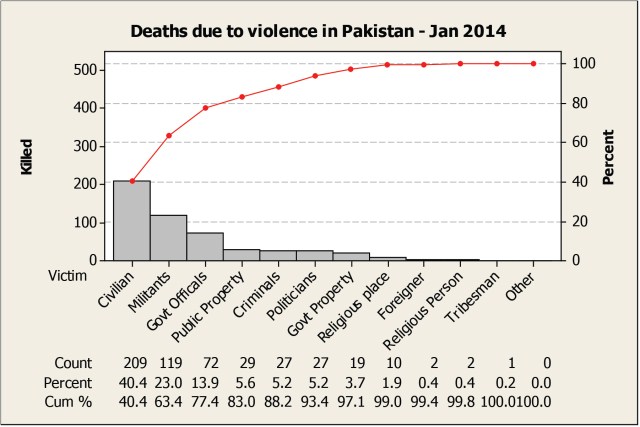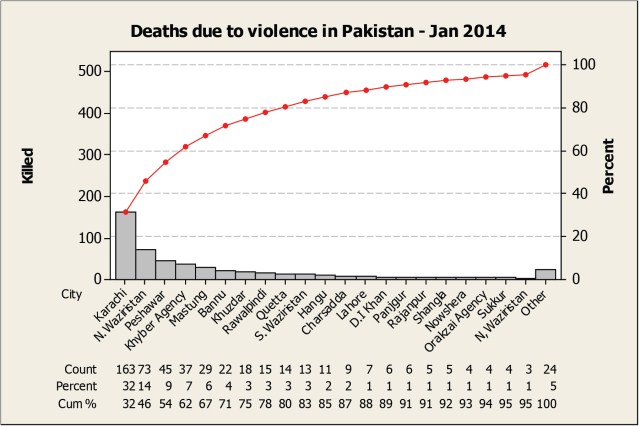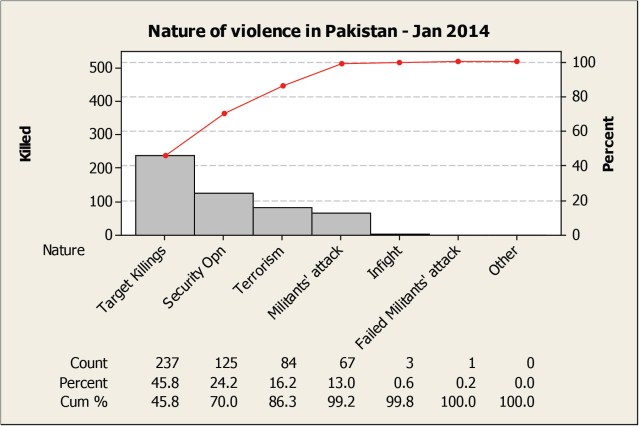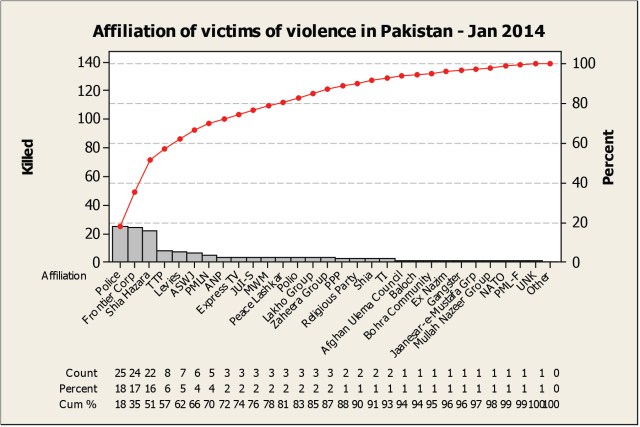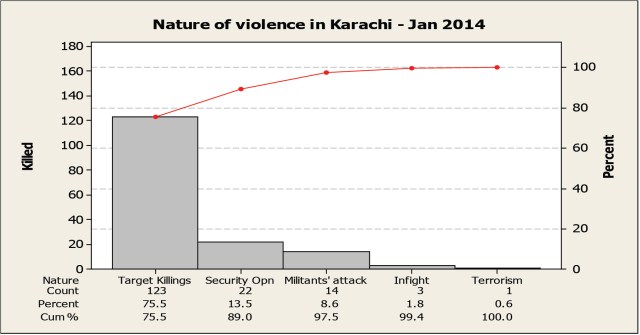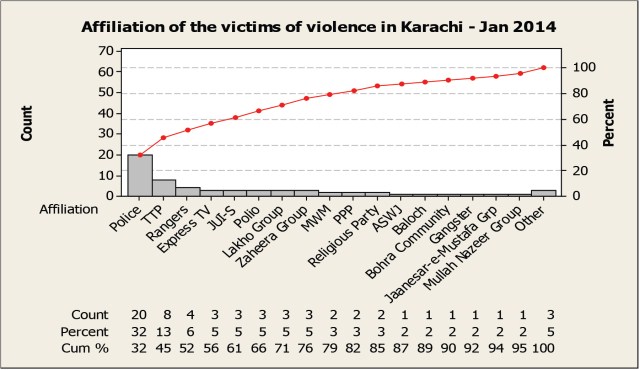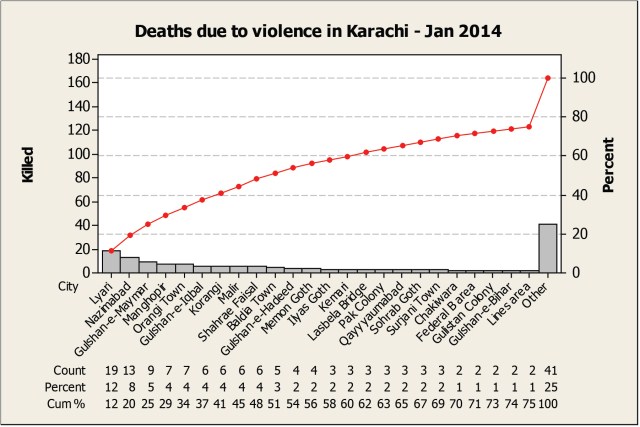The declining trend in crime rate observed during the last quarter of 2013 took an upward turn this month and recorded a 60% increase in the number of casualties caused by the violence. All indicators of violence went up this month reflecting the vulnerability of the security agencies in the face of militancy that can always manage to resurface with more ferocity and aggressiveness. Target killings[1], the most common method of violence, rose up 60% this month, militants– attacks[2] went up by 80%, and the deaths due to acts of terrorism[3] were up by more than 150% (Refer to graph 1).
Graph 1: Rise in deaths due to violence ´ (Dec 2013 versus Jan 2014)
For the first time, the CIA operated unmanned space vehicle, popularly known as drone, remained off the air space of Pakistani territory for over a month. Yet, the militants, who blamed drone attack as one of the reasons for their acts of violence, continued unleashing their wrath in the country while the government kept requesting them to have a dialogue and bring an end to the lawlessness in the country.
All these events and other facts reported in the national newspapers are collected to make this report as informative and factual as possible. Errors and omissions, as always a possibility in all statistical works including this one, are expected. However, such mistakes do not grossly affect the basic objective of this report. This report analyzes the overall impact of the ongoing violence in the country and shows the areas that suffered the most in terms of deaths and injuries to the people due to violence. It also reports the number of people that were claimed to have been killed by the different outlawed organizations. The religious communities that became target of sectarian violence are also covered in this report.
This report mainly covers the following topics:
Deaths due to violence in the country during January 2014
Nature of violence and the number of victims
Militants– attacks, terrorism, and military operation
Sabotage activities of the militants
Violence and counter-violence operation in Karachi
Areas highly affected of violence in Karachi
Methods of violence in Karachi
CRSS will appreciate receiving comments that the readers may have on this report.
Report prepared by:
Mohammad Nafees
Senior Research Fellow
Center for Research and Security Studies
Data compilation by:
Fariha Farry
NOTE: Readers can approach CRSS for source of any information included in the report. Please send your request to: [mail@crss.pk]
OVERVIEW
Deaths due to violence in the country during January 2014:
In January 2014 the death toll of violence went up to 517 from 280 recorded in December 2013 but it was less than the figure of 641 recorded in January 2013. Sindh was on top among all other provinces in loss of human lives due to violence while the Punjab was the least affected of it as it lost only 31 persons during the month (Refer to graph 2). After civilians the next highest victims of violence were militants because of military operation in FATA (Refer to graph 3). Karachi, as usual, had the highest victims of violence in the country followed by North Waziristan and Peshawar (Refer to graph 4).
Graph 2: Deaths due to violence in Pakistan ´ Jan 2014
Graph 3: Victims of violence in Pakistan ´ Jan 2014
Graph 4: Number of persons killed in cities:
Nature of violence and the number of victims:
Target killing was the major cause of deaths in the country during the month of January. Security operation to counter violence was the next highest cause of deaths followed by terrorism and militants– attacks (Refer to graph 5). Nearly 75% of the total deaths were caused by the acts of violence like target killings, terrorism, and militants– attacks. Tehreek-e-Taliban of Pakistan (TTP) and Lashkar-e-Islami (LI) were the two major militant groups that claimed to have killed 53 and 22 persons. The counter violence operations carried out by the military, police, rangers, and frontier constabulary caused deaths to nearly 125 lawless elements in the country (Refer to graph xxx).
Graph 5: Nature of violence in Pakistan ´ Jan 2014:
The data on the affiliation of the victims of violence shows that the Police Department lost the highest number of their personnel (25) in the country followed by Frontier Constabulary (24), and Levies (7). Other than security officials, there were a number of civilians belonging to different segments of the society, significant among them were Shia Hazara community who lost 22 persons in sectarian violence. Political and religious parties also lost their activists and even the media personnel (Express TV channel) became target of violence (Refer to graph 6). What it shows is that most of the country and its people are in the grip of violence and it constantly spreading its reach from one part of the country to the other part and from one segment of the society to the next one.
Graph 6: Affiliation of the victims of violence in Pakistan ´ Jan 2014:
Militants– attacks, terrorism, and military operation:
Militants– attacks and acts of terrorism killed 151 persons and wounded 368 in the country during the month of January forcing Pak Army to carry out an operation against the militants in North Waziristan. The blatant militants– attacks against the armed forces and civilians that led the army to take retaliatory operation against the militants were:
January 17, 2014
PESHAWAR: Eight persons were killed and more than 60 injured when a bomb went off during Maghrib prayers inside the jam-packed mosque in the Tableeghi Markaz near Shami Road in Hassan Garhi on Thursday. The Tehrik-e-Taliban Pakistan (TTP) condemned the blast and said it has no connection with the blast[4].
January 20, 2014
BANNU/PESHAWAR: At least 20 soldiers were killed and 30 others sustained injuries in an explosion targeting a military convoy in Bannu city on Sunday, military officials said. The Pakistani Taliban claimed responsibility for the deadly attack on the troops.’We are very happy to claim responsibility for the attack on the Pakistan Army in Bannu. As I mentioned earlier, we will continue such attacks on the army[5].
January 21, 2014
RAWALPINDI: In the latest terrorist strike in the city garrison area, 14 persons, including seven soldiers, were killed and 29 others injured on Monday morning. The Tehrik-e-Taliban Pakistan (TTP) owned the Rawalpindi attack as they did Sunday hit that left 26 soldiers dead and over 20 wounded in Bannu[6].
January 22, 2014
QUETTA: Twenty-two people were killed and 31 others sustained injuries in a suicide blast on a bus of Shia pilgrims in the Daringar area of Mastung district, 60 kilometres from the provincial capital, on Tuesday. The LJ spokesman Nooruddin Zangi claimed responsibility of the attack[7].
These brazen attacks on security officials and civilians amid an atmosphere where the government has been trying to engage the militants in peaceful negotiation was a great shock to the people and the army officials. To teach the militants a lesson in their own language, the armed forces carried out retaliatory operation against the militants to target their hideouts in North Waziristan resulting in deaths of 89 persons and injuries to 28 persons.
Sabotage activities of the militants:
The list of crimes that the outlawed militant organizations commit every day in the country also includes their sabotage activities. In January alone, they carried out 19 terrorist activities to destroy different government and public properties in the country. In KP, they destroyed 11 properties, 5 in Balochistan, 2 in FATA and one in Islamabad. Among the destroyed properties, there were 5 schools, 4 houses, 3 gas pipelines, 2 Hujras (guest rooms), 2 power pylons, 2 electricity lines, 1 food outlet, and one guest room of the advisor to the CM of KP.
Violence and counter-violence operation in Karachi – January 2014
Among all other provinces, Sindh had the highest victims of violence in January 2014 and in Sindh, it was only Karachi that lost 163 persons out of the total deaths of 170 persons. Three fourth of the total victims of violence in Karachi were gunned down in target killing incidents and the remaining were the victims of security operation, militants– attacks, and terrorism(Refer to graph 7). During the ongoing targeted operation in Karachi, Police and Rangers arrested nearly 600 criminals in the month of January and killed 22 suspected criminals.
Graph 7: Nature of violence in Karachi ´ Jan 2014:
In Karachi, 60% of the total victims of violence were civilians while on country level civilian ratio was 40%. After civilians, the second highest victims of violence were government officials – 20 policemen and 4 rangers (Refer to graph 8). The emergence of the Taliban in Karachi had also been a cause of a rise in the number of deaths due to violence in the city. Karachi Police lost one of their bravest and efficient police officials, SP CID, Choudhry Aslam, during this month in a remote controlled explosion. Taliban proudly claimed to have carried out this operation. A suicide attack on a Rangers– check post in Nazimabad was also claimed to have been carried out by the Taliban wherein 4 rangers were killed and 10 injured.
Graph 8: Affiliation of the victims of violence in Karachi ´ Jan 2014:
Areas highly affected of violence in Karachi ´ January 2014
Based on the number of deaths at different locations in the city, Lyari, Nazimabad, Gulshan-e-Maymar, Manghopir, Gulshan-e-Iqbal, Korangi, and Malir were found to be the highly affected areas of violence besides many other places in the city (Refer to graph 9).
Graph 9: Deaths due to violence in Karachi ´ Jan 2014:
Methods of violence in Karachi:
93 persons were gunned down besides the 33 dead bodies that were also found in the city. 19 persons (criminals) were killed in encounter with the security agencies. Suicide attacks that are very common methods of violence in KP, FATA, and Balochistan have now started occurring in Karachi too. It proves the claim of the Taliban that they have become stronger financially, politically, and influentially. This month, a suicide attack on Ranger office killed 4 Rangers. Choudhry Aslam, SSP CID, and his three guards were also victims of an improvised explosive device.
Conclusion:
Despite the government efforts of having peace talks with the militants, there was no respite in occurrences of violence in the country. On the contrary, the incidents of violence went up this month raising serious question about the possibility of restoration of peace in the country through dialogue. Even the sphere of militancy spread to other places of the country posing serious threat for the law enforcement agencies to handle a menace they were never trained for. In North Waziristan, military retaliated to militants– attacks with air raids and claimed to have killed several militants in their hideouts. While these claims were suspected by the analysts and observers, the resultant effects of such operations still need to be assessed and evaluated.
The emergence of militant elements in the commercial capital of the country, Karachi, is a proof of how easily the militants can manage to move from one location to another and then regroup themselves for their next operation as and when they are assigned the task. The targeted operation in Karachi seems to have provided the militants with an opportunity to carry out their operation at an ease since the leading political party of the city, MQM, is busy in handling a situation emanating from the targeted operation. Another outcome of the targeted operation in Karachi is the sharpening of feuds among the different gangsters functioning in Lyari. It has also taken a number of human lives so far with no end to it in the sight.
Other than the militants, there are supporters of each group in the country that oppose and support actions based on their sympathies and alliances. Human lives carry no or little value for them as long as their objectives are served well. Would we ever come out of this sense of parochialism?

